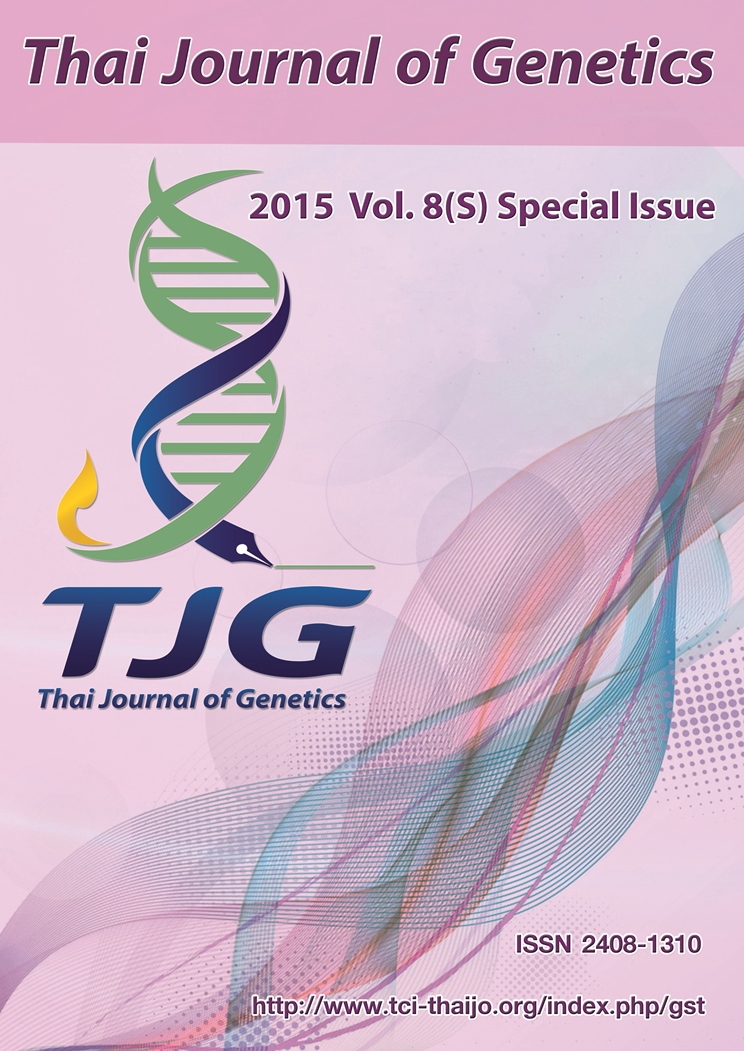ผลความเป็นพิษต่อเซลล์ และความเป็นพิษต่อยีนของครีมกำจัดขนต่อเซลล์เม็ดเลือดขาวของคนในอาหารเพาะเลี้ยง (Cytotoxicity and genotoxicity effect of hair removal cream on human lymphocytes culture)
Keywords:
ครีมกำจัดขน (hair removal cream), ความเป็นพิษระดับเซลล์ (cytotoxicity), โครโมโซมผิดปกติ (chromosome aberrations)Abstract
The present study aims to investigate the possible cytotoxicity and genotoxicity effects of hair removal cream on human lymphocytes. Human peripheral blood cultured from the three healthy volunteers were exposed to the hair removal cream solution at different concentrations, then harvested after 12 hrs. subjection. The mitotic index and chromosome aberrations in metaphase cells were used to examine for the alteration in the lymphocytes. The results showed that hair removal cream solution at 0.01, 0.025, 0.05 and 0.075 g/mL found to react as mitotic poison by reducing mitotic division to 81.31, 71.49, 61.76 and 45.52% respectively.The hair removal cream solution-induced decrease in the mitotic index depend on the increasing of the hair removal cream concentrations. The result also indicated the presence of 5 types ofchromosome aberrations.These included single chromatid gap, isochromatid gap, single chromatid breaks, isochromatid break and dicentric chromosome. The sticky, unstable and short chromosome, were also found in the treatment. These are the indications of both cytotoxicity and genotoxicity of hair removal cream solution on human lymphocytes culture in vitro. All the parameters obtained from the experiment were statistically significant when compared to that of controls.
บทคัดย่อ
จุดมุ่งหมายของการศึกษาครั้งนี้เพื่อศึกษาผลความเป็นพิษต่อระดับเซลล์ และความเป็นพิษต่อยีนของครีมกำจัดขนต่อเซลล์เม็ดเลือดขาวของคนในอาหารเพาะเลี้ยง โดยศึกษาจากตัวอย่างเลือดของคนที่มีสุขภาพดีจำนวน 3 คน โดยให้เซลล์เม็ดเลือดขาวได้รับสารทดสอบความเข้มข้นที่แตกต่างกัน เป็นเวลา 12 ชั่วโมง ก่อนการเก็บเกี่ยวเซลล์ แล้วจึงตรวจสอบค่าอัตราการแบ่งเซลล์ และความผิดปกติของโครโมโซมในระยะเมทาเฟส จากการทดลองพบว่าสารละลายครีมกำจัดขนจะส่งผลต่อเซลล์เม็ดเลือดขาว ที่ระดับความเข้มข้น 0.01, 0.025, 0.05 และ 0.075 g/mL มีผลไปยับยั้งการแบ่งตัวของเซลล์ ทำให้อัตราการแบ่งเซลล์ลดลงเท่ากับ 81.31, 71.49, 61.76 และ 45.52 เปอร์เซ็นต์ตามลำดับ สารละลายจากครีมกำจัดขนจะชักนำให้อัตราการแบ่งเซลล์ลดลงเมื่อความเข้มข้นของครีมกำจัดขนเพิ่มขึ้น นอกจากนี้ยังพบความผิดปกติของโครโมโซม 5 แบบคือ singlechromatid gap, isochromatid gap, single chromatid breaks, isochromatid breaks และ dicentric chromosome และยังพบความผิดปกติของโครโมโซมแบบเกาะกลุ่ม ไม่คงรูป และหดสั้น จากผลการศึกษาครั้งนี้แสดงให้เห็นว่าสารละลายของครีมกำจัดขนจะแสดงความเป็นพิษต่อเซลล์ และยีนของโครโมโซมเซลล์เม็ดเลือดขาวในมนุษย์ และการทดลองในทุกทรีตเมนต์มีความแตกต่างทางสถิติอย่างมีนัยสำคัญเมื่อเทียบกับการทดลองควบคุม
References
กมลทิพย์ ดอกประทุม (2550) ผลของสบู่เหลวอนามัยที่มีต่อโครโมโซมเม็ดเลือดขาวของคน.ปัญหาพิเศษปริญญาตรีมหาวิทยาลัยเกษตรศาสตร์วิทยาเขตกำแพงแสน. นครปฐม.
กรมควบคุมเครื่องสำอาง สำนักงานคณะกรรมการอาหารและยา(2535) แนวทางการปฏิบัติงาน เกี่ยวกับพระราชบัญญัติเครื่องสำอาง พ.ศ. 2535. สำนักงานกิจการโรงพิมพ์องค์การสงเคราะห์ทหารผ่านศึก.กรุงเทพฯ.
นฤพร เพ็ชร์กลาง (2546) ผลทางไซโตจินิติคของยาสลบชนิดสูดดม Diethy ether Halothanและ Isofluraneต่อเซลล์เม็ดเลือดขาวของคนในอาหารเพาะเลี้ยง.วิทยานิพนธ์ปริญญาโท มหาวิทยาลัยเกษตรศาสตร์, กรุงเทพฯ.
พิมพ์รัตน์ชาญปรีชญาศิริลักษณ์ เอี่ยมธรรมนฤพร เพ็ชร์กลาง (2552)ผลทางไซโตจินิติคของน้ำยาย้อมสีผมต่อเซลล์ เม็ดเลือดขาวของมนุษย์ในอาหารเพาะเลี้ยง.วารสารมหาวิทยาลัยนเรศวร 17(2): 151-156.
มุนินทร เปรมปรีดิ์(2551) ผลทางไซโตจินิติคของสเปรย์ระงับกลิ่นกายชนิดน้ำต่อเซลล์เม็ดเลือดขาวของคนในอาหารเพาะเลี้ยง.ปัญหาพิเศษปริญญาตรีมหาวิทยาลัย เกษตรศาสตร์วิทยาเขตกำแพงแสน. นครปฐม.
มณทินีธีรารักษ์จันทณี สนธิ (2553)ผลของสารกำจัดวัชพืช อะลาคลอร์ ต่อกิจกรรมการแบ่งเซลล์ของหอมหัวใหญ่วารสารเกษตรพระจอมเกล้า28 (2): 83-89.
โรงพยาบาลราชวิถี (ม.ป.ป.)กลไกการออกฤทธิ์ของยาเคมีบำบัด.แหล่งที่มา: http://110.164.68.234/chemo/ images/files/chemical1.pdf(17 พฤษภาคม 2558)
สุวิดา เลาหภัทรพันธุ์ศรัณย์ ตันตะราวงศา ธวัชชัย แพชะมัด (2555)การกำจัดขน
ชั่วคราวด้วยสารเคมี(Temporary Chemical Depilation)วารสารไทยเภสัชศาสตร์ และวิทยาการสุขภาพ 7(2): 106-110.
อมรา คัมภิรานนท์ (2540)พันธุศาสตร์ของเซลล์สำนักพิมพ์มหาวิทยาลัยเกษตรศาสตร์กรุงเทพฯ
อมรา คัมภิรานนท์ เลิศชัย เจริญธัญรักษ์ (2535) ผงซักฟอกชนิดฮาร์ดและซอฟท์ดีเทอเจนท์ต่อเซลล์เม็ดเลือดขาวของคนในอาหารเลี้ยงเซลล์รายงานการประชุมทางวิชาการของมหาวิทยาลัยเกษตรศาสตร์ ครั้งที่ 30, มหาวิทยาลัยเกษตรศาสตร์. กรุงเทพฯ.น. 755-762.
อรพรรณ ชัยมณี วิวัฒน์ เอกบูรณะวัฒน์ (2555) Propylene glycol. แหล่งที่มา: http://www.summacheeva.org/index_thaitox_propylene_glycol.htm (14 มกราคม 2558)
Ambulkar PS, Ghosh SK, Ingole IV, Pal AK (2009) Genotoxic and cytotoxic effects of antibacterial drug, ciprofloxacin, on human lymphocytes in vitro. Nepal Med Coll J 11(3): 147-151.
Andersson HC, Kihlman BK (1989) Carcinogenesis. Oxford J 10: 123-130.
Bai YH, Peng YM, Yin WQ, Liu H, Liu FY, Duan SB, Xiao P (2012) –Aminophenol and –paraphenylenediamineinduce injury and apotosis of human HK-2 proximal tubular epithetilial cells. J Nephrol 25:481-489.
BullaLMC, AmbrosioEP, MartinsABT, DellaRosa VA (2014) Viability of lymphocyte culture,at different times after blood collection,for karyotype analysis. J Bras Patol Med Lab 50:124-130.
Christina L, Burnett, BS, Wilma FB, Donald VB, Curtis DK , James GM Jr, Ronald CS, Thomas JS, Paul WS, Andersen FA (2009) Final amended report on the safety assessment of ammonium thioglycolate, butyl thioglycolate, calcium thioglycolate, ethanolamine thioglycolate, ethyl thioglycolate, glyceryl thioglycolate, isooctyl thioglycolate, isopropyl thioglycolate, magnesium thioglycolate, methyl thioglycolate, potassium thioglycolate, sodium thioglycolate, and thioglycolic acid. Int J Toxicol 28(4S): 68-113.
EI-Ghamery AA, EI-Kholy MA, Abou EI, Yousser MA (2003) Evaluation of cytological effects of Zn2+ in relation to germination and growth of Nigella sativa L. and Triticum aestivum L. Mutation Res 537: 29-41.
Hsu TC, Jan CL, Kanitha HL (1986) Cytogenetics assays for mitotic poisons using aromatic animal cells. Chem Mut 10: 155-181.
Khalandar BBD, Vasudev V (2015) Differential response of biochemical parameters to EMS and MMS treatments and their dose effect relationship on chromosomes in induced diabetic mouse. Egypt J Med Human Genet 16:301-312.
Marianne M (2010) Parabens and breast cancer. Natural Med J.2 (10): 1-8.
Molinier B (1994) In vitro mammalian cytogenetic test in cultured human lymphocytes, 2-thioglycolic acid. CIT study No. 10279 MLH (Elf Atochem SA, unpublished report).
Sumner AT (2003) Chromosomes Organization. Blackwell Publishing, North Berwick.
Thompson PW (2003) Ammonium Thioglycolate 71%: Reverse Mutation Assay "Ames test" usingSalmonella typhimurium. Safepharm Laboratories Ltd., study no. 1158/039 (Bruno Bock ChemischeFabrik GmbH & Co KG unpublished report.
Ul-Ain Q, Bukhari IH (2013) Determination and toxicological effects of metals on human skin by using hair removing creams and lotions by spectroscopic techniques. Int Res J Pharm App Sci 3(4): 9-11.
Young YH, Chuu JJ, Liu SH, Lin-Shiau SY (2001) Toxic effects of potassium bromated and
thioglycolate on vestibuloocular reflex systems of Guinea pigs and humans. Toxicol Appl Pharmacol 177:103-111.
Zanoni TB, Tiago M, Faiao-Flores F, de Moraes Barros SB, Bast A, Hageman G, de Oliveira DP, Maria-Engler SS (2014) Basic Red 51, a permitted semi-permanent hair dye, is cytotoxic to human skin cells: Studies in monolayer and 3D skin model using human keratinocytes (HaCaT). Toxicol Lett 227:139-149.
Zeiger E, Anderson B, Haworth S, Lawlor T, Mortelmans K, Speck W (1987) Salmonella mutagenicity tests: III. Results from the testing of 255 chemicals. Environ Mutagen 9(suppl.9), 1-109.



